 By Mark Gillies
By Mark Gillies
November 10, 2014
BURLINGTON, ON.
The year 2014 marks the 100th anniversary of some of our boys leaving Burlington by train to head for Europe where they would take part in the Great War. Ity was to be the war to end all wars.
My grandfather served in that war and died later from the effects of gas poisoning, leaving my grandmother with three children, all under the age of 5, to raise by herself.
One of the three children was my father. I have very strong emotional ties to soldiers, particularly those involved in both world wars. I have put together a collection of information about the 38 soldiers from Burlington who went to Europe to fight for King and Country but did not return home.
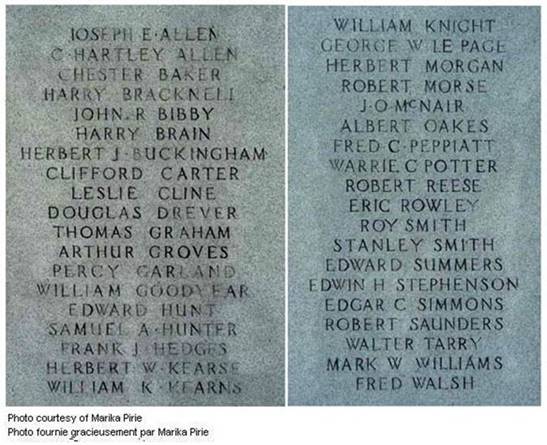 Their names are inscribed on the Burlington Cenotaph. Every time I pass by the Cenotaph, I always pause to read the name. I feel as if I am with them on Remembrance Day.
Their names are inscribed on the Burlington Cenotaph. Every time I pass by the Cenotaph, I always pause to read the name. I feel as if I am with them on Remembrance Day.
It always touched me – and I needed to know more about them. Who were these young men?
I believe this collection is the most information that any one has gathered on these 38 soldiers.

More than 300 men – out of a population of less than 2000 left to fight the first wold war – 38 of then did not return.
When they went off to war Burlington had a population that probably peaked at 2,000, if that. More than 300 men, all very young, boarded the train; they came from farms, local shops and whatever Burlington had in the way of small industry at the time.
Everyone in town knew these men – Burlington was at that time a very tight knit agricultural community – everyone in town was affected. As You read the news clipping I have collected you can follow the story of many of these men. There are four men about whom we know nothing. This kind of research is a hobby for me – and while I think I’ve exhausted all the sources I know of – there may be families in the community who can add to the information I have collected. Be in touch with Gazette publisher who will pass your information along to me.
The sons of several of the prominent Burlington families boarded that train at Freeman Station and didn’t return: the names of Kerns, Cline and Allen boys are engraved on that cenotaph,
Let me begin with those we know nothing about other than their names. George W Le Page, Roy Smith, Herbert Morgan and William Knight. Perhaps over time we will learn more about these men.
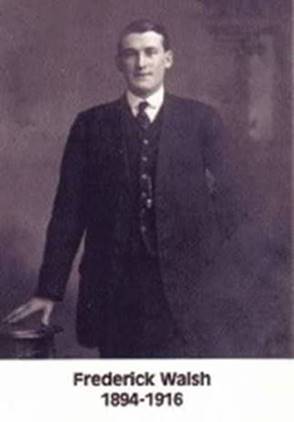 We don’t know very much about Frederick Walsh. His name is on a cenotaph elsewhere as well as the one in Burlington and there is a Canadian forces marker with his name on it in a cemetery. He is well dressed wearing a finely cut suit jacket and a vest suggesting perhaps something in the way of a professional background.
We don’t know very much about Frederick Walsh. His name is on a cenotaph elsewhere as well as the one in Burlington and there is a Canadian forces marker with his name on it in a cemetery. He is well dressed wearing a finely cut suit jacket and a vest suggesting perhaps something in the way of a professional background.
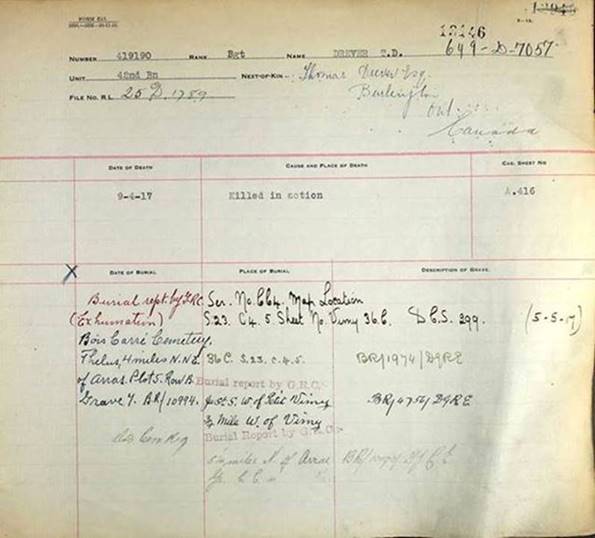
The Army had a form like this for every man. Some had significant detail – others precious little. For some there wasn’t even as much as this. We know this much about Sgt Drever
We know more about Douglas Drever. The government kept a sheet of paper for each member of the army that set out where they were born and when they died. It is referred to as the army death details document.
Thomas Douglas Drever was a Sgt in the who was killed in action on September 4, 1917 and was buried. He was then exhumed and reburied close to the Vimy Memorial.
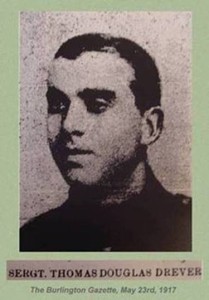 There is a family tombstone, believed to be in Milton upon which the name of Sgt Drever has been inscribed. It was the custom then to add the name of a person killed in action to the family tomb stone even though the remains were elsewhere.
There is a family tombstone, believed to be in Milton upon which the name of Sgt Drever has been inscribed. It was the custom then to add the name of a person killed in action to the family tomb stone even though the remains were elsewhere.
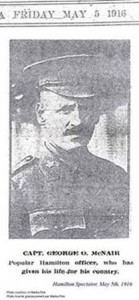
George Orme McNair’s name is on the Burlington cenotaph. There isn’t anything in the way of information that ties him to what was then a town.
George Orme McNair was a Captain. He traveled to Toronto to sign up and was described as a resident of Hamilton. He was killed two months after he arrived at the trenches.
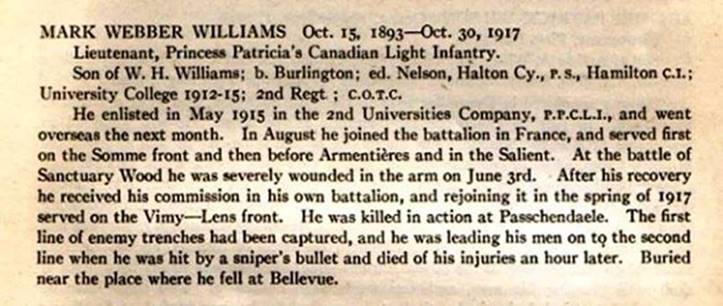 Private M. W. Williams was killed by a sniper’s bullet on October 30th, 1917. Prior to his death he had been seriously injured and was commissioned as an officer in the field and made a Lieutenant.
Private M. W. Williams was killed by a sniper’s bullet on October 30th, 1917. Prior to his death he had been seriously injured and was commissioned as an officer in the field and made a Lieutenant.
It was while leading his men that a sniper shot him.
















If you want to see a copy of a Canadian WW 1 veteran’s Attestation Paper, you can do so here:
https://www.bac-lac.gc.ca/eng/discover/military-heritage/first-world-war/first-world-war-1914-1918-cef/Pages/search.aspx
You can also get copies of all the records they have on a soldier by mail. It took months to receive and at the time it cost me $45.00 but it was well worth the wait.
(My grandfather survived the front lines of WW 1 and WW 2.)